Mapping Coniferous Forest Distribution in a Semi-Arid Area Based on Multi-Classifier Fusion and Google Earth Engine Combining Gaofen-1 and Sentinel-1 Data: A Case Study in Northwestern Liaoning, China
Abstract
:1. Introduction
2. Study Area and Materials
2.1. Study Area
2.2. Remote Sensing Images and Preprocessing
2.3. Training and Validation Samples
3. Methods
3.1. The Base Classifiers
3.2. Multiple Classifier Fusion
3.3. Accuracy Assessments
4. Results and Analysis
4.1. The Separability of Coniferous Forest from Other Land Types in Remote Sensing Images
4.2. The Performance of Different Classifiers in Coniferous Forest Extraction
4.3. The Performance of Coniferous Forest Extraction Using Different Data Sources
4.4. Comparison with Other Datasets
4.5. The Statistics on Coniferous Forest Area in Northwestern Liaoning
5. Discussion
5.1. Implications of Mapping Coniferous Forests in Northwestern Liaoning
5.2. The Performance of the Proposed Methodological Framework
5.3. The Generality of the Proposed Methodological Framework
5.4. Limitations and Future Work
6. Conclusions
Author Contributions
Funding
Data Availability Statement
Acknowledgments
Conflicts of Interest
References
- Bonan, G.B. Forests and climate change: Forcings, feedbacks, and the climate benefits of forests. Science 2008, 320, 1444–1449. [Google Scholar] [CrossRef]
- Buma, B.; Hayes, K.; Weiss, S.; Lucash, M. Short interval fires increasing in the boreal forest as fire self-regulation decays, especially in drier coniferous forest landscapes. Sci. Rep. 2022, 12, 10322935. [Google Scholar] [CrossRef] [PubMed]
- Zhai, J.; Wang, L.; Liu, Y.; Wang, C.; Mao, X. Assessing the effects of china’s three-north shelter forest program over 40 years. Sci. Total Environ. 2023, 857, 159354. [Google Scholar] [CrossRef] [PubMed]
- Li, B. The alpine timberline of Tibet. In Forest Development in Cold Climates; Springer: Berlin/Heidelberg, Germany, 1993; pp. 511–527. [Google Scholar] [CrossRef]
- Abella, S.R.; Springer, J.D. Effects of tree cutting and fire on understory vegetation in mixed conifer forests. For. Ecol. Manag. 2015, 335, 281–299. [Google Scholar] [CrossRef]
- Goeking, S.A.; Tarboton, D.G. Forests and water yield: A synthesis of disturbance effects on streamflow and snowpack in western coniferous forests. J. For. 2020, 118, 172–192. [Google Scholar] [CrossRef]
- Cassell, B.A.; Scheller, R.M.; Lucash, M.S.; Hurteau, M.D.; Loudermilk, E.L. Widespread severe wildfires under climate change lead to increased forest homogeneity in dry mixed-conifer forests. Ecosphere 2019, 10, e02934. [Google Scholar] [CrossRef]
- Furnas, B.J. Rapid and varied responses of songbirds to climate change in california coniferous forests. Biol. Conserv. 2020, 241, 108347. [Google Scholar] [CrossRef]
- Liu, L.; Guo, Y.; Li, Y.; Zhang, Q.; Li, Z.; Chen, E.; Yang, L.; Mu, X. Comparison of Machine Learning Methods Applied on Multi-Source Medium-Resolution Satellite Images for Chinese Pine (Pinus tabulaeformis) Extraction on Google Earth Engine. Forests 2022, 13, 677. [Google Scholar] [CrossRef]
- Zhang, B.; Zhao, L.; Zhang, X. Three-Dimensional Convolutional Neural Network Model for Tree Species Classification Using Airborne Hyperspectral Images. Remote Sens. Environ. 2020, 247, 111938. [Google Scholar] [CrossRef]
- Ge, S.; Gu, H.; Su, W.; Praks, J.; Antropov, O. Improved Semisupervised UNet Deep Learning Model for Forest Height Mapping With Satellite SAR and Optical Data. IEEE J. Sel. Top. Appl. Earth Obs. Remote Sens. 2022, 15, 5776–5787. [Google Scholar] [CrossRef]
- Zhang, Q.; Ge, L.; Hensley, S.; Isabel Metternicht, G.; Liu, C.; Zhang, R. PolGAN: A Deep-Learning-Based Unsupervised Forest Height Estimation Based on the Synergy of PolInSAR and LiDAR Data. ISPRS J. Photogramm. Remote Sens. 2022, 186, 123–139. [Google Scholar] [CrossRef]
- Hang, X.; Li, Y.; Li, X.; Xu, M.; Sun, L. Estimation of Chlorophyll-a Concentration in Lake Taihu from Gaofen-1 Wide-Field-of-View Data through a Machine Learning Trained Algorithm. J. Meteorol. Res. 2022, 36, 208–226. [Google Scholar] [CrossRef]
- Jie, Z.; Zhang, Y.; Zhou, T.; Sun, Y.; Yang, Z.; Zheng, S. Research on the identification of land types and tree species in the Engebei ecological demonstration area based on GF-1 remote sensing. Ecol. Inform. 2023, 77, 102242. [Google Scholar] [CrossRef]
- Luo, H.; Dai, S.; Li, M.; Liu, E.; Zheng, Q.; Hu, Y.; Yi, X. Comparison of Machine Learning Algorithms for Mapping Mango Plantations Based on Gaofen-1 Imagery. J. Integr. Agric. 2020, 19, 2815–2828. [Google Scholar] [CrossRef]
- Ling, Y.; Teng, S.; Liu, C.; Dash, J.; Morris, H.; Pastor-Guzman, J. Assessing the Accuracy of Forest Phenological Extraction from Sentinel-1 C-Band Backscatter Measurements in Deciduous and Coniferous Forests. Remote Sens. 2022, 14, 674. [Google Scholar] [CrossRef]
- Rüetschi, M.; Schaepman, M.E.; Small, D. Using Multitemporal Sentinel-1 C-Band Backscatter to Monitor Phenology and Classify Deciduous and Coniferous Forests in Northern Switzerland. Remote Sens. 2018, 10, 55. [Google Scholar] [CrossRef]
- Han, H.; Wan, R.; Li, B. Estimating Forest Aboveground Biomass Using Gaofen-1 Images, Sentinel-1 Images, and Machine Learning Algorithms: A Case Study of the Dabie Mountain Region, China. Remote Sens. 2021, 14, 176. [Google Scholar] [CrossRef]
- Gorelick, N.; Hancher, M.; Dixon, M.; Ilyushchenko, S.; Thau, D.; Moore, R. Google Earth Engine: Planetary-Scale Geospatial Analysis for Everyone. Remote Sens. Environ. 2017, 202, 18–27. [Google Scholar] [CrossRef]
- Zhao, F.; Sun, R.; Zhong, L.; Meng, R.; Huang, C.; Zeng, X.; Wang, M.; Li, Y.; Wang, Z. Monthly Mapping of Forest Harvesting Using Dense Time Series Sentinel-1 SAR Imagery and Deep Learning. Remote Sens. Environ. 2022, 269, 112822. [Google Scholar] [CrossRef]
- Adrian, J.; Sagan, V.; Maimaitijiang, M. Sentinel SAR-Optical Fusion for Crop Type Mapping Using Deep Learning and Google Earth Engine. ISPRS J. Photogramm. Remote Sens. 2021, 175, 215–235. [Google Scholar] [CrossRef]
- Xu, H.; Xiao, X.; Qin, Y.; Qiao, Z.; Long, S.; Tang, X.; Liu, L. Annual Maps of Built-Up Land in Guangdong from 1991 to 2020 Based on Landsat Images, Phenology, Deep Learning Algorithms, and Google Earth Engine. Remote Sens. 2022, 14, 3562. [Google Scholar] [CrossRef]
- Liu, L.; Zhang, Q.; Guo, Y.; Chen, E.; Li, Z.; Li, Y.; Wang, B.; Ri, A. Mapping the Distribution and Dynamics of Coniferous Forests in Large Areas from 1985 to 2020 Combining Deep Learning and Google Earth Engine. Remote Sens. 2023, 15, 1235. [Google Scholar] [CrossRef]
- Hirayama, H.; Sharma, R.C.; Tomita, M.; Hara, K. Evaluating Multiple Classifier System for the Reduction of Salt-and-Pepper Noise in the Classification of Very-High-Resolution Satellite Images. Int. J. Remote Sens. 2019, 40, 2542–2557. [Google Scholar] [CrossRef]
- Yang, H.; Huang, S.; Guo, S.; Sun, G. Multi-Classifier Fusion Based on MI–SFFS for Cross-Subject Emotion Recognition. Entropy 2022, 24, 705. [Google Scholar] [CrossRef] [PubMed]
- Zhao, H.; Liu, H. Multiple Classifiers Fusion and CNN Feature Extraction for Handwritten Digits Recognition. Granul. Comput. 2020, 5, 411–418. [Google Scholar] [CrossRef]
- Li, M.-Y.; Fang, L.-D.; Duan, C.-Y.; Cao, Y.; Yin, H.; Ning, Q.-R.; Hao, G.-Y. Greater Risk of Hydraulic Failure Due to Increased Drought Threatens Pine Plantations in Horqin Sandy Land of Northern China. For. Ecol. Manag. 2020, 461, 117980. [Google Scholar] [CrossRef]
- Fang, Y.; Jiang, D.; Liu, C.; Zhao, C.; Ke, Z.; Lin, Y.; Li, F.; Yu, Y. Evaluation on the Forecast Skills of Precipitation and Its Influencing Factors in the Flood Season in Liaoning Province of China. Atmosphere 2023, 14, 668. [Google Scholar] [CrossRef]
- Chokkalingam, U. Learning Lessons from China’s Forest Rehabilitation Efforts: National Level Review and Special Focus on Guangdong Province; Center for International Forestry Research (CIFOR): Bogor, Indonesia, 2006; ISBN 978-979-24-4667-8. [Google Scholar]
- Carle, J.B.; Duval, A.; Ashfordc, S. The Future of Planted Forests. Int. For. Rev. 2020, 22, 65–80. [Google Scholar] [CrossRef]
- Qin, X.; Zhang, Z.; Huang, C.; Dehghan, M.; Zaiane, O.R.; Jagersand, M. U2-Net: Going Deeper with Nested U-Structure for Salient Object Detection. Pattern Recognit. 2020, 106, 107404. [Google Scholar] [CrossRef]
- He, K.; Zhang, X.; Ren, S.; Sun, J.; He, K.; Zhang, X.; Ren, S.; Sun, J. Deep residual learning for image recognition. In Proceedings of the IEEE Conference on Computer Vision and Pattern Recognition, Las Vegas, NV, USA, 27–30 June 2016; pp. 770–778. [Google Scholar]
- Cortes, C.; Vapnik, V. Support-Vector Networks. Mach. Learn. 1995, 20, 273–297. [Google Scholar] [CrossRef]
- Zhou, L.; Luo, T.; Du, M.; Chen, Q.; Liu, Y.; Zhu, Y.; He, C.; Wang, S.; Yang, K. Machine Learning Comparison and Parameter Setting Methods for the Detection of Dump Sites for Construction and Demolition Waste Using the Google Earth Engine. Remote Sens. 2021, 13, 787. [Google Scholar] [CrossRef]
- Breiman, L. Random Forests. Mach. Learn. 2001, 45, 5–32. [Google Scholar] [CrossRef]
- Chen, J.; Chen, J.; Liao, A.; Cao, X.; Chen, L.; Chen, X.; He, C.; Han, G.; Peng, S.; Lu, M.; et al. Global Land Cover Mapping at 30m Resolution: A POK-Based Operational Approach. ISPRS J. Photogramm. Remote Sens. 2015, 103, 7–27. [Google Scholar] [CrossRef]
- Wang, Z.; Mountrakis, G. Accuracy Assessment of Eleven Medium Resolution Global and Regional Land Cover Land Use Products: A Case Study over the Conterminous United States. Remote Sens. 2023, 15, 3186. [Google Scholar] [CrossRef]
- Gong, P.; Wang, J.; Yu, L.; Zhao, Y.; Zhao, Y.; Liang, L.; Niu, Z.; Huang, X.; Fu, H.; Liu, S.; et al. Finer Resolution Observation and Monitoring of Global Land Cover: First Mapping Results with Landsat TM and ETM+ Data. Int. J. Remote Sens. 2013, 34, 2607–2654. [Google Scholar] [CrossRef]
- Yang, J.; Huang, X. The 30 m Annual Land Cover Dataset and Its Dynamics in China from 1990 to 2019. Earth Syst. Sci. Data 2021, 13, 3907–3925. [Google Scholar] [CrossRef]
- Huan, V.D. Accuracy Assessment of Land Use Land Cover LULC 2020 (ESRI) Data in Con Dao Island, Ba Ria—Vung Tau Province, Vietnam. IOP Conf. Ser. Earth Environ. Sci. 2022, 1028, 012010. [Google Scholar] [CrossRef]
- Zhao, J.; Dong, Y.; Zhang, M.; Huang, L. Comparison of Identifying Land Cover Tempo-Spatial Changes Using GlobCover and MCD12Q1 Global Land Cover Products. Arab. J. Geosci. 2020, 13, 792. [Google Scholar] [CrossRef]
- Zhang, X.; Liu, L.; Chen, X.; Gao, Y.; Xie, S.; Mi, J. GLC_FCS30: Global Land-Cover Product with Fine Classification System at 30 m Using Time-Series Landsat Imagery. Earth Syst. Sci. Data 2021, 13, 2753–2776. [Google Scholar] [CrossRef]
- Xiong, N.; Chen, H.; Li, R.; Su, H.; Dai, S.; Wang, J. A Method of Chestnut Forest Identification Based on Time Series and Key Phenology from Sentinel-2. Remote Sens. 2023, 15, 5374. [Google Scholar] [CrossRef]
- Brovelli, M.A.; Sun, Y.; Yordanov, V. Monitoring Forest Change in the Amazon Using Multi-Temporal Remote Sensing Data and Machine Learning Classification on Google Earth Engine. ISPRS Int. J. Geo-Inf. 2020, 9, 580. [Google Scholar] [CrossRef]
- Vahid, N.; Beloiu, M.; Darvishsefat, A.A.; Griess, V.C.; Maftei, C.; Waser, L.T. Mapping tree species composition in a Caspian temperate mixed forest based on spectral-temporal metrics and machine learning. Int. J. Appl. Earth Obs. Geoinf. 2023, 116, 103154. [Google Scholar] [CrossRef]
- Xie, W.; Zhao, X.; Fan, D.; Zhang, J.; Wang, J. Assessing Spatio-Temporal Characteristics and Their Driving Factors of Ecological Vulnerability in the Northwestern Region of Liaoning Province (China). Ecol. Indic. 2024, 158, 111541. [Google Scholar] [CrossRef]
- Meng, X.; Gao, X.; Li, S.; Lei, J. Spatial and Temporal Characteristics of Vegetation NDVI Changes and the Driving Forces in Mongolia during 1982–2015. Remote Sens. 2020, 12, 603. [Google Scholar] [CrossRef]
- Gao, H.; Huang, Y. Impacts of the Three-North Shelter Forest Program on the Main Soil Nutrients in Northern Shaanxi China: A Meta-Analysis. For. Ecol. Manag. 2020, 458, 117808. [Google Scholar] [CrossRef]
- Sheykhmousa, M.; Mahdianpari, M.; Ghanbari, H.; Mohammadimanesh, F.; Ghamisi, P.; Homayouni, S. Support Vector Machine Versus Random Forest for Remote Sensing Image Classification: A Meta-Analysis and Systematic Review. IEEE J. Sel. Top. Appl. Earth Obs. Remote Sens. 2020, 13, 6308–6325. [Google Scholar] [CrossRef]
- Serbouti, I.; Raji, M.; Hakdaoui, M.; Pradhan, B.; Lee, C.-W.; Alamri, A.M. Pixel and Object-Based Machine Learning Classification Schemes for Lithological Mapping Enhancement of Semi-Arid Regions Using Sentinel-2A Imagery: A Case Study of the Southern Moroccan Meseta. IEEE Access 2021, 9, 119262–119278. [Google Scholar] [CrossRef]
- Shoeibi, A.; Khodatars, M.; Jafari, M.; Moridian, P.; Rezaei, M.; Alizadehsani, R.; Khozeimeh, F.; Gorriz, J.M.; Heras, J.; Panahiazar, M.; et al. Applications of Deep Learning Techniques for Automated Multiple Sclerosis Detection Using Magnetic Resonance Imaging: A Review. Comput. Biol. Med. 2021, 136, 104697. [Google Scholar] [CrossRef]
- Xu, K.; Tian, Q.; Zhang, Z.; Yue, J.; Chang, C.-T. Tree Species (Genera) Identification with GF-1 Time-Series in A Forested Landscape, Northeast China. Remote Sens. 2020, 12, 1554. [Google Scholar] [CrossRef]
- Dostálová, A.; Wagner, W.; Milenković, M.; Hollaus, M. Annual Seasonality in Sentinel-1 Signal for Forest Mapping and Forest Type Classification. Int. J. Remote Sens. 2018, 39, 7738–7760. [Google Scholar] [CrossRef]
- Mondini, A.C.; Guzzetti, F.; Chang, K.-T.; Monserrat, O.; Martha, T.R.; Manconi, A. Landslide Failures Detection and Mapping Using Synthetic Aperture Radar: Past, Present and Future. Earth-Sci. Rev. 2021, 216, 103574. [Google Scholar] [CrossRef]
- Liu, H.; Liao, T.; Wang, Y.; Qian, X.; Liu, X.; Li, C.; Li, S.; Guan, Z.; Zhu, L.; Zhou, X.; et al. Fine-Grained Wetland Classification for National Wetland Reserves Using Multi-Source Remote Sensing Data and Pixel Information Expert Engine (PIE-Engine). GIScience Remote Sens. 2023, 60, 2286746. [Google Scholar] [CrossRef]
- Wang, H.; Guo, L.; Dou, Z.; Lin, Y. A New Method of Cognitive Signal Recognition Based on Hybrid Information Entropy and D-S Evidence Theory. Mob. Netw. Appl. 2018, 23, 677–685. [Google Scholar] [CrossRef]
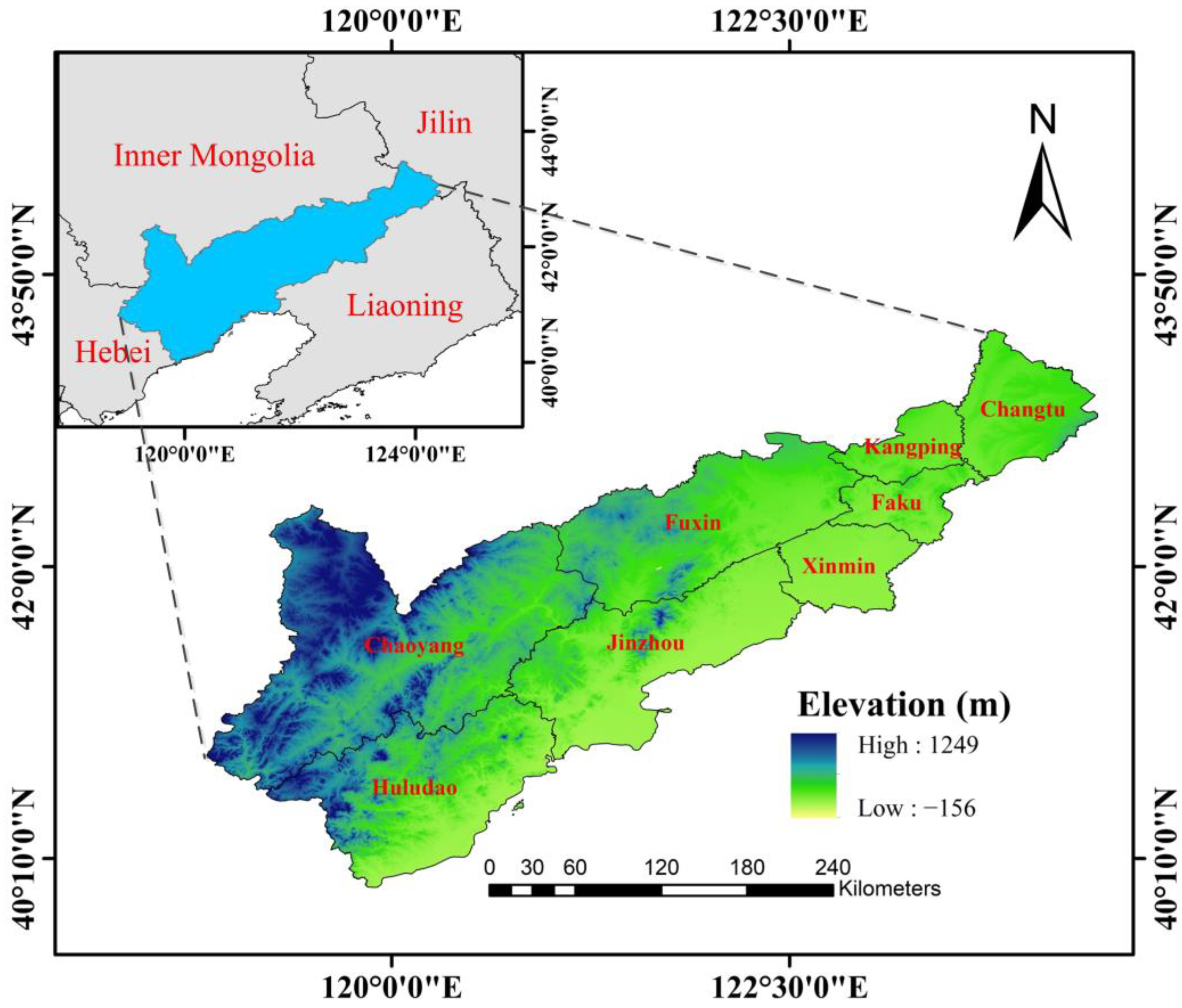

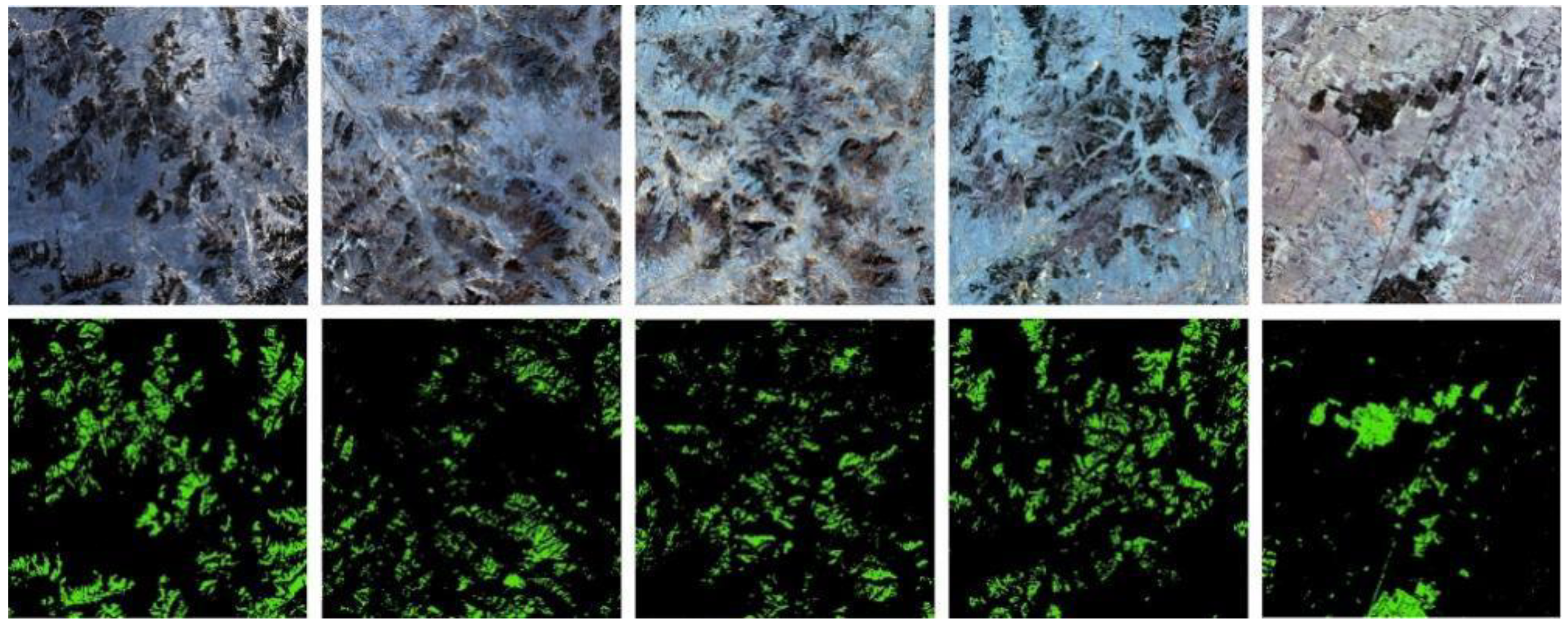
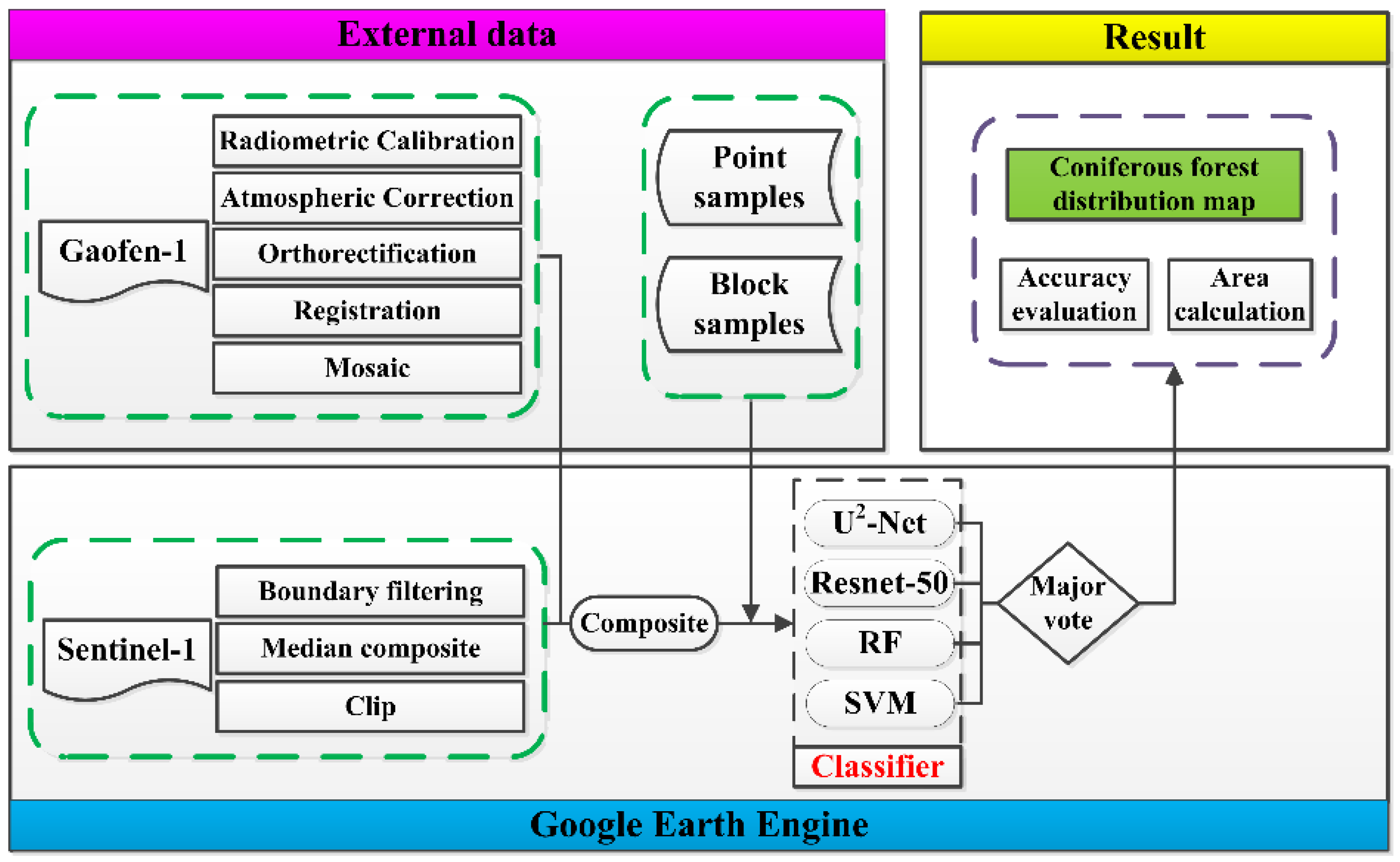

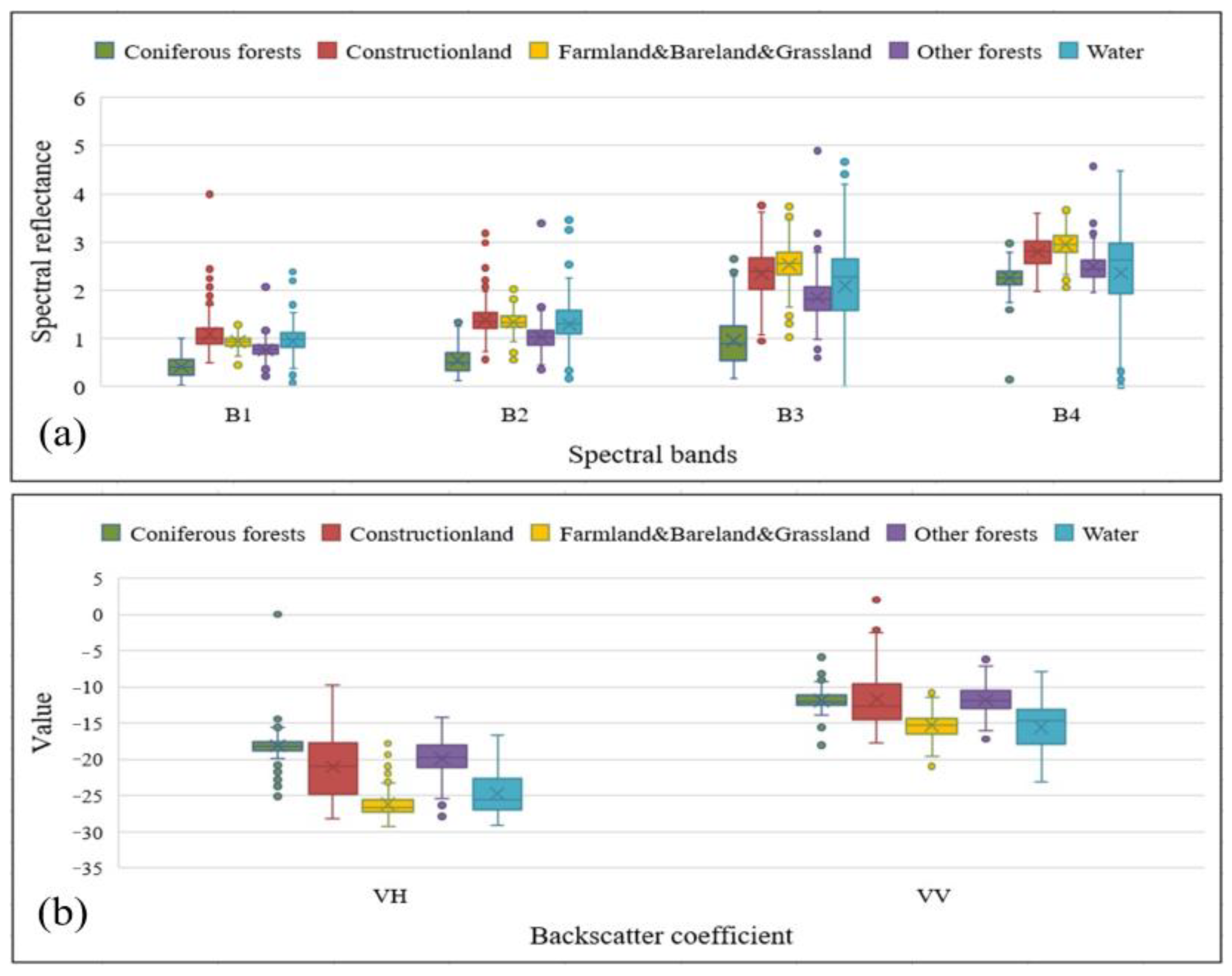

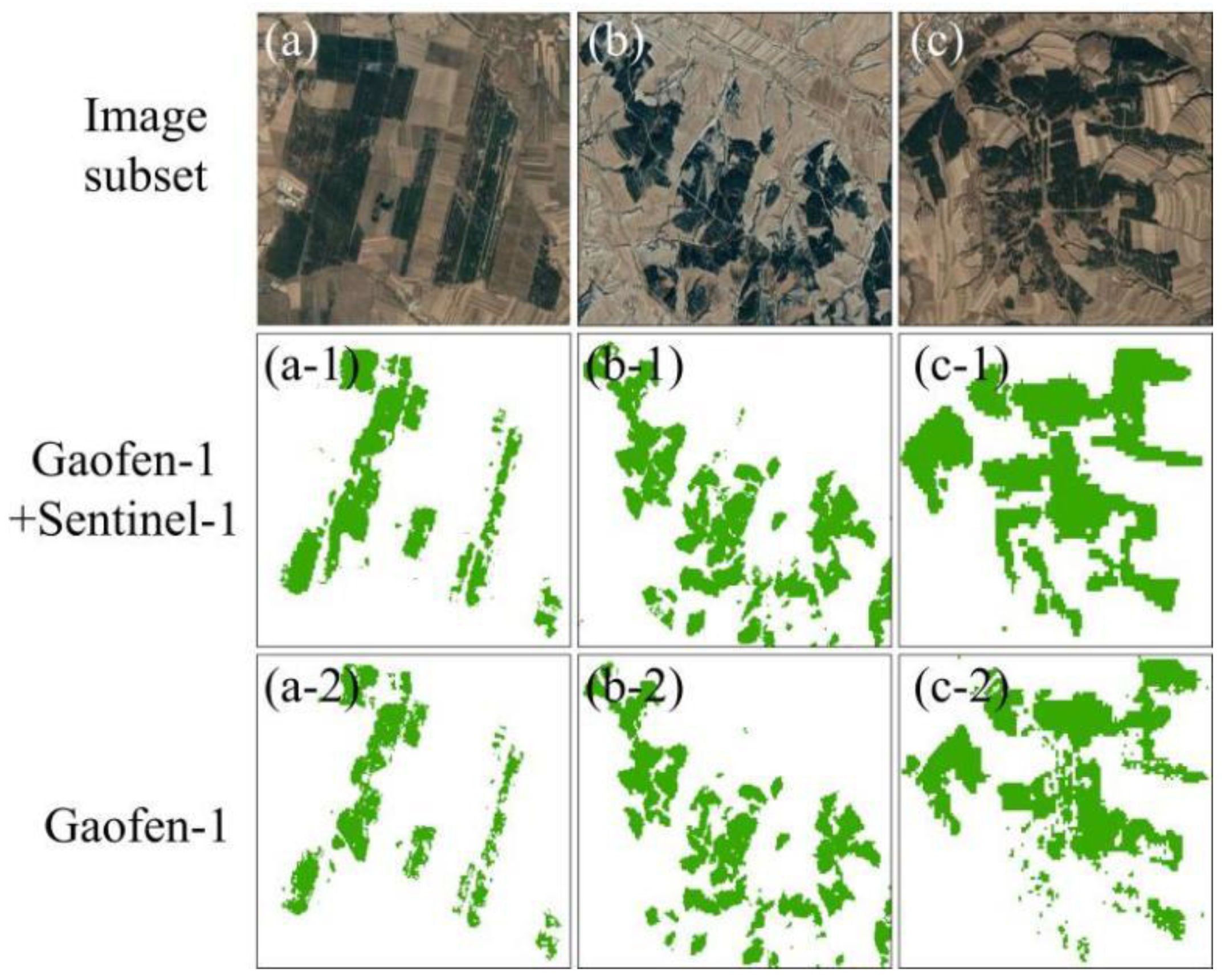

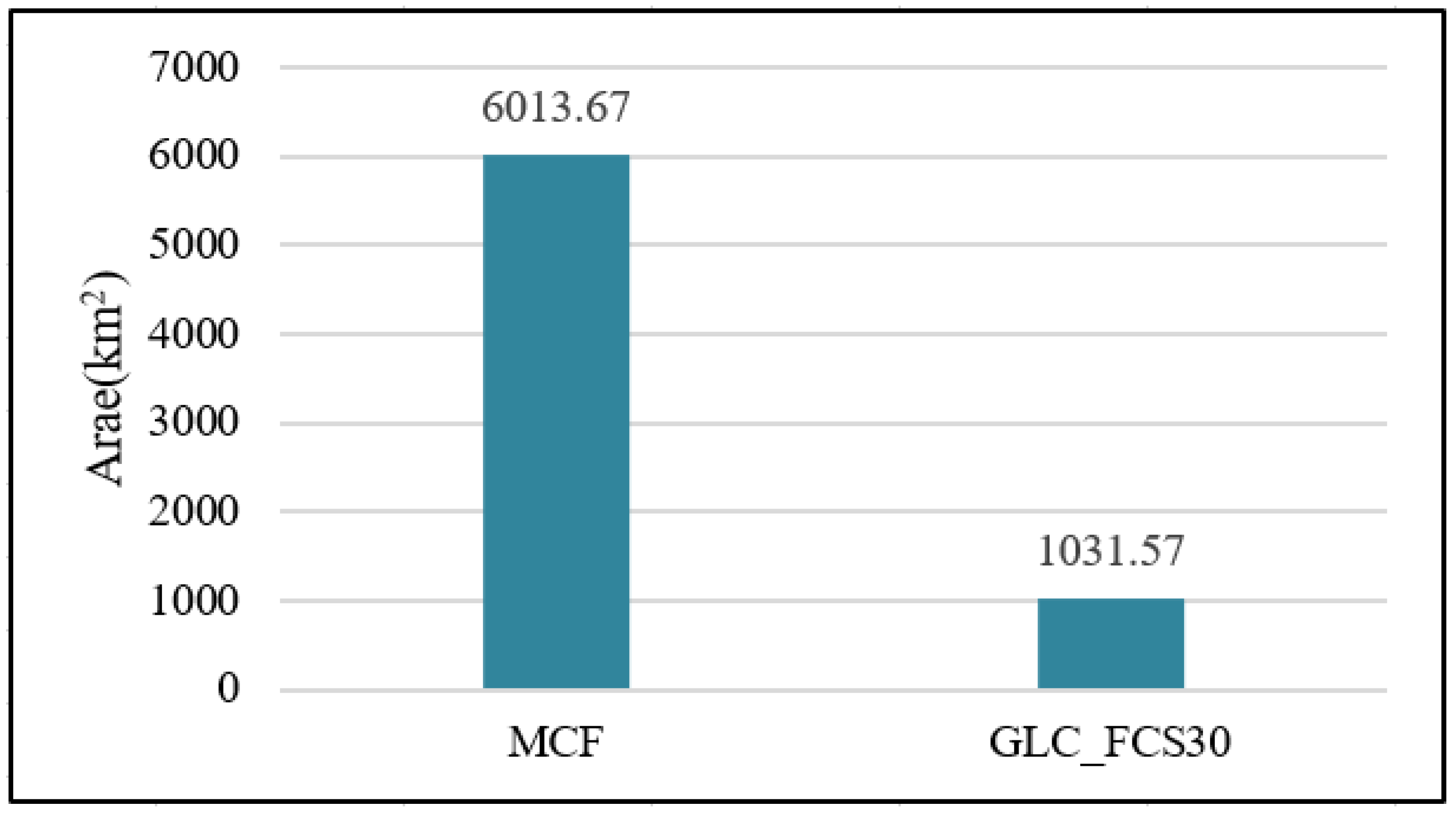

| Satellites | Band Wavelength (µm) | Spatial Resolution (m) | Revisit Time (Day) | Period | |
|---|---|---|---|---|---|
| Gaofen-1 WFV | Band 1 (Blue) | 0.45–0.52 | 16 | 4 | 1 November 2019~20 April 2020 |
| Band 2 (Green) | 0.52–0.59 | 16 | |||
| Band 3 (Red) | 0.63–0.69 | 16 | |||
| Band 4 (NIR) | 0.77–0.89 | 16 | |||
| Sentinel-1 | VV | / | 10 | 5 | |
| VH | / | ||||
| ID | Category | Number | ||
|---|---|---|---|---|
| 1 | Point samples | Coniferous forest | / | 416 |
| Non-coniferous forest | Cultivated land, grassland, and bare land | 706 | ||
| Water | 322 | |||
| Other woodland | 439 | |||
| Construction land | 1221 | |||
| Total | 3104 | |||
| 2 | Block samples | Coniferous forest | / | 20 |
| Non-coniferous forest | ||||
| Classifier | F1_Score (%) | Precision (%) | Recall (%) | OA (%) | Kappa |
|---|---|---|---|---|---|
| U2-Net | 97.1 | 96.3 | 98.0 | 97.6 | 0.960 |
| Resnet-50 | 96.0 | 94.5 | 97.6 | 96.9 | 0.944 |
| SVM | 95.6 | 92.8 | 98.5 | 96.9 | 0.932 |
| RF | 90.1 | 84.5 | 96.5 | 93.3 | 0.850 |
| MCF | 98.1 | 97.9 | 98.3 | 98.6 | 0.970 |
| Data Source | F1_Score (%) | Precision (%) | Recall (%) | OA (%) | Kappa |
|---|---|---|---|---|---|
| Gaofen-1 + Sentinel-1 | 98.1 | 97.9 | 98.3 | 98.6 | 0.970 |
| Gaofen-1 | 97.2 | 96.6 | 97.6 | 97.5 | 0.962 |
| Name | Non-Coniferous Forest (km2) | Coniferous Forest (km2) | Total (km2) | Proportion (%) |
|---|---|---|---|---|
| Chaoyang | 16,877.23 | 2839.55 | 19,716.78 | 14.40 |
| Huludao | 9068.63 | 1521.96 | 10,590.59 | 14.37 |
| Fuxin | 9544.86 | 764.72 | 10,309.58 | 7.42 |
| Jinzhou | 9427.17 | 590.75 | 10,017.92 | 5.90 |
| Changtu | 4181.11 | 142.27 | 4323.38 | 3.29 |
| Xinmin | 3282.34 | 15.86 | 3298.20 | 0.48 |
| Faku | 2201.42 | 78.59 | 2280.01 | 3.45 |
| Kangping | 2105.29 | 59.96 | 2165.25 | 2.77 |
| Total | 56,688.05 | 6013.67 | 62,701.71 | 9.59 |
Disclaimer/Publisher’s Note: The statements, opinions and data contained in all publications are solely those of the individual author(s) and contributor(s) and not of MDPI and/or the editor(s). MDPI and/or the editor(s) disclaim responsibility for any injury to people or property resulting from any ideas, methods, instructions or products referred to in the content. |
© 2024 by the authors. Licensee MDPI, Basel, Switzerland. This article is an open access article distributed under the terms and conditions of the Creative Commons Attribution (CC BY) license (https://creativecommons.org/licenses/by/4.0/).
Share and Cite
Liu, L.; Zhang, Q.; Guo, Y.; Li, Y.; Wang, B.; Chen, E.; Li, Z.; Hao, S. Mapping Coniferous Forest Distribution in a Semi-Arid Area Based on Multi-Classifier Fusion and Google Earth Engine Combining Gaofen-1 and Sentinel-1 Data: A Case Study in Northwestern Liaoning, China. Forests 2024, 15, 288. https://doi.org/10.3390/f15020288
Liu L, Zhang Q, Guo Y, Li Y, Wang B, Chen E, Li Z, Hao S. Mapping Coniferous Forest Distribution in a Semi-Arid Area Based on Multi-Classifier Fusion and Google Earth Engine Combining Gaofen-1 and Sentinel-1 Data: A Case Study in Northwestern Liaoning, China. Forests. 2024; 15(2):288. https://doi.org/10.3390/f15020288
Chicago/Turabian StyleLiu, Lizhi, Qiuliang Zhang, Ying Guo, Yu Li, Bing Wang, Erxue Chen, Zengyuan Li, and Shuai Hao. 2024. "Mapping Coniferous Forest Distribution in a Semi-Arid Area Based on Multi-Classifier Fusion and Google Earth Engine Combining Gaofen-1 and Sentinel-1 Data: A Case Study in Northwestern Liaoning, China" Forests 15, no. 2: 288. https://doi.org/10.3390/f15020288
APA StyleLiu, L., Zhang, Q., Guo, Y., Li, Y., Wang, B., Chen, E., Li, Z., & Hao, S. (2024). Mapping Coniferous Forest Distribution in a Semi-Arid Area Based on Multi-Classifier Fusion and Google Earth Engine Combining Gaofen-1 and Sentinel-1 Data: A Case Study in Northwestern Liaoning, China. Forests, 15(2), 288. https://doi.org/10.3390/f15020288







